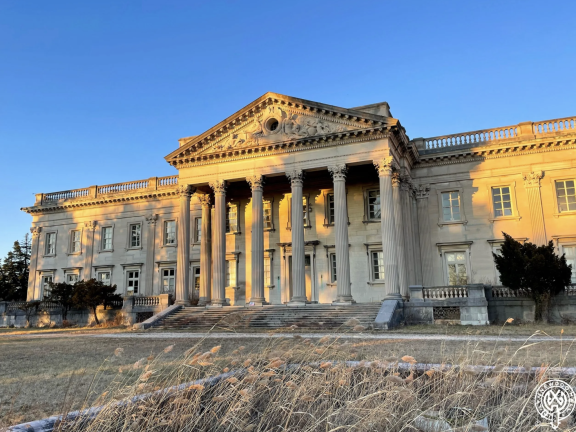The Widener Family and Lynnewood Hall: Cultural Enrichment and Architectural Grandeur

A hard working man who attained generational wealth from his humble beginnings, Peter A. B. Widener became one of the richest men in the Philadelphia area toward the end of the 19th century. Initially earning a fortune as a butcher who supplied for Union troops and later becoming the Treasurer for the City of Philadelphia, Widener exponentially increased his wealth by establishing himself in the oil, steel, tobacco, and railroad industries. The majority of Septa lines that Philadelphians have access to today were established thanks to Widener and his partnership that founded the Philadelphia Transportation Company.
With this enormous wealth and growing family, Widener sought to create an extravagant home. Following the unfortunate loss of his wife, Widener established Lynnewood Hall in 1899, bringing his two sons and their families along with him. The mansion was not only built to house the Widener family, but also to showcase what would become one of the most valuable residential art galleries in the country. As a fellow Philadelphia businessman and lover of architecture, William Welsh Harrison, resident of Grey Towers Castle, connected Widener with his architect, Horace Trumbauer, whose design of Lynnewood Hall would boost him into fame and lead him to design other iconic buildings like the Philadelphia Museum of Art.

Located in Elkins Park, Lynnewood Hall boasts expansive grounds and a Neoclassical Revival facade. Inside, you find 110 rooms, complete with family suites, rooms for 40 staff members, and a high-ceilinged art gallery with the ghosts of immaculate paintings on the walls. Peter Widener was an art aficionado, with special attachment to Italian, English, and Chinese art, as well as esteemed artists like Van Dyke and Rembrandt. His 14 Rembrandt paintings made up the largest Rembrandt collection outside of Buckingham Palace and included famous works such as Woman Weighing Gold. Widener’s keen eye helped design the splendid art gallery, and later, his son, Joseph, continued the artful legacy of the family while making some of his own personal changes to the home. Joseph became the sole heir and executor of Lynnewood Hall after his brother, George, and his son perished in the Titanic sinking in 1912 and his father, Peter A. B. Widener, passed in 1915.
Joe and Ella Widener became esteemed public figures of their own with their devotion to art and philanthropy. Joe traveled the world as an equestrian and helped institute ethical practices for horse racing in the U. S., and Ella was a patron of the arts, providing for operas and symphonies. She was even great friends with Anna Pavlova, the admired Russian ballerina, who came to visit Lynnewood Hall. The family had connections across the world and invited countless other international visitors into their home and art gallery. These visitors included Henri Matisse, the famed French visual artist, the Prince and Princess of Sweden, one of the Romanov sisters, and it is even rumored that the Duke and Duchess of Windsor visited, though Joe Widener refused to be present for this controversial visit.

Lynnewood Hall has other particular affiliations with international cultures and history. The Wideners employed a diverse staff, with Widener’s son Joe employing a French governess who taught his children the French language for the many visits to Paris with their mother, Ella. Their son, Peter A. B. Widener II, became the American liaison to France during WWII due to his familiarity with the country and his ability to speak French. Joseph’s secretary to the art collection, Edith Standen, later became the first “Monuments Woman” in World War II, protecting art around the world during wartime. Other employees at Lynnewood Hall had backgrounds in different countries, such as Germany, Italy, Sweden, and Ireland. This meshing of different cultures was unusual for such a household, but contributed to its multicultural atmosphere.
The children were also raised with philanthropy and a love for the arts and different cultures in mind. After Joseph and Ella’s passing, the majority of the art collection was donated to the National Gallery of Art, with some pieces still being retained by the family. When the third generation to live in Lynnewood Hall inherited the estate and family money, philanthropic efforts continued with George Widener Jr.’s large donation to the Pennsylvania Military College. Large amounts of the Lynnewood Hall estate were sold off and the home went through many hands over the decades, becoming a Theological Seminary in the 1950’s until it was finally purchased by the Lynnewood Hall Preservation Foundation in 2023.
The Lynnewood Hall Preservation Foundation, Inc. is committed to sharing the history of Lynnewood Hall and the Widener Family by sharing their stories and committing to the reconstruction of the estate. All these years later, Lynnewood Hall’s grandness and intricate details still leave visitors speechless, and the foundation will allow the public to witness this greatness once again.
